2012 CHRYSLER 300 SRT radiator cap
[x] Cancel search: radiator capPage 431 of 557
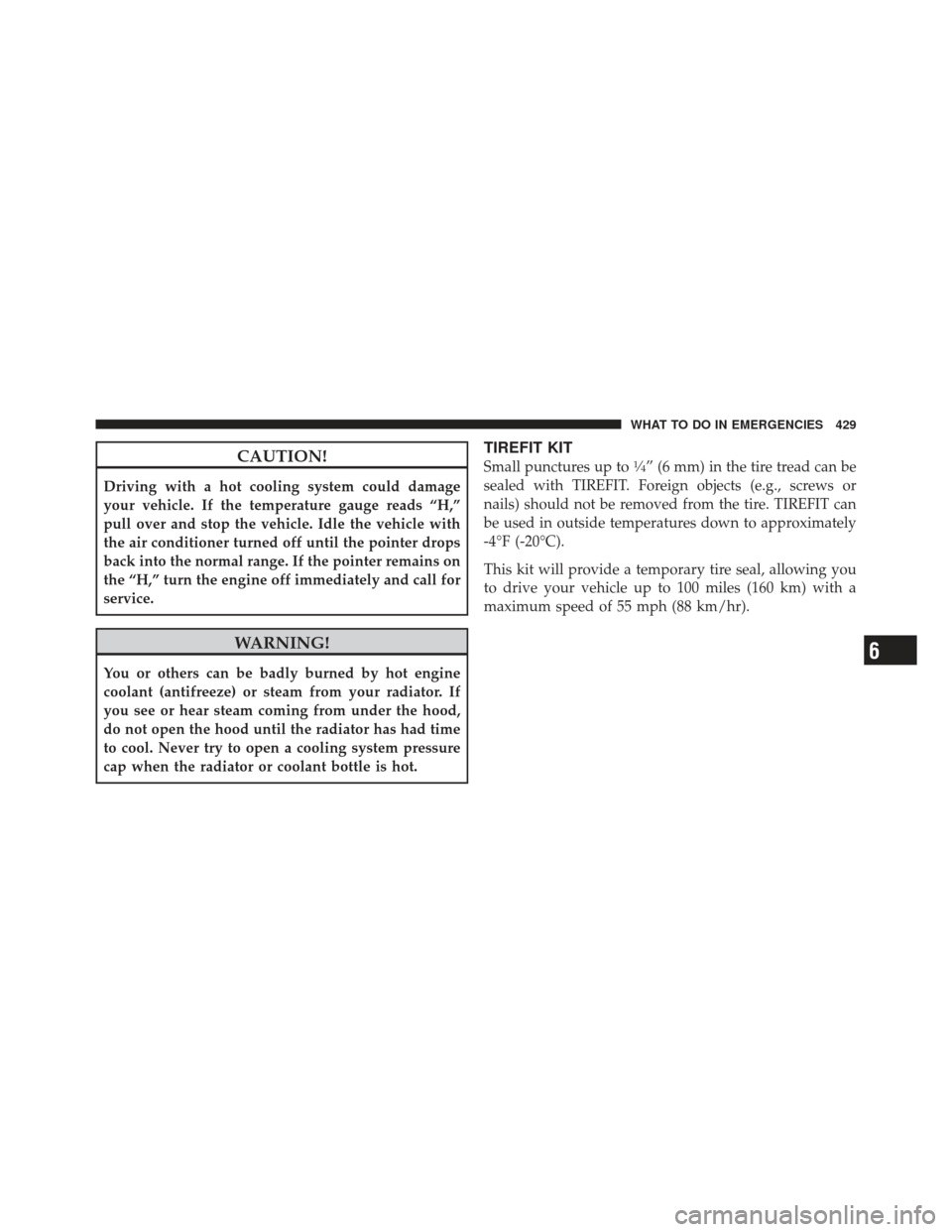
CAUTION!
Driving with a hot cooling system could damage
your vehicle. If the temperature gauge reads “H,”
pull over and stop the vehicle. Idle the vehicle with
the air conditioner turned off until the pointer drops
back into the normal range. If the pointer remains on
the “H,” turn the engine off immediately and call for
service.
WARNING!
You or others can be badly burned by hot engine
coolant (antifreeze) or steam from your radiator. If
you see or hear steam coming from under the hood,
do not open the hood until the radiator has had time
to cool. Never try to open a cooling system pressure
cap when the radiator or coolant bottle is hot.
TIREFIT KIT
Small punctures up to1�4” (6 mm) in the tire tread can be
sealed with TIREFIT. Foreign objects (e.g., screws or
nails) should not be removed from the tire. TIREFIT can
be used in outside temperatures down to approximately
-4°F (-20°C).
This kit will provide a temporary tire seal, allowing you
to drive your vehicle up to 100 miles (160 km) with a
maximum speed of 55 mph (88 km/hr).
6
WHAT TO DO IN EMERGENCIES 429
Page 472 of 557
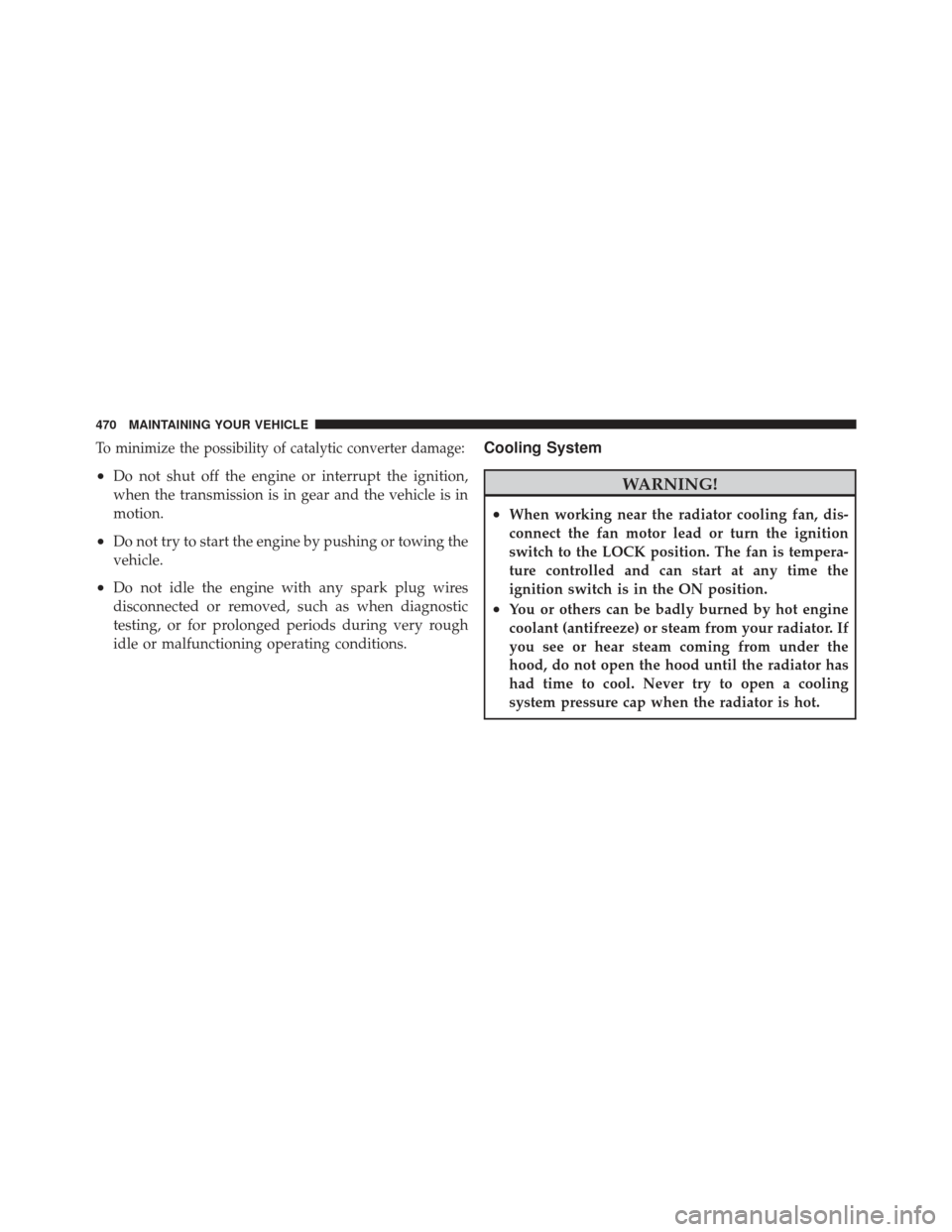
To minimize the possibility of catalytic converter damage:
•Do not shut off the engine or interrupt the ignition,
when the transmission is in gear and the vehicle is in
motion.
•Do not try to start the engine by pushing or towing the
vehicle.
•Do not idle the engine with any spark plug wires
disconnected or removed, such as when diagnostic
testing, or for prolonged periods during very rough
idle or malfunctioning operating conditions.
Cooling System
WARNING!
•When working near the radiator cooling fan, dis-
connect the fan motor lead or turn the ignition
switch to the LOCK position. The fan is tempera-
ture controlled and can start at any time the
ignition switch is in the ON position.
•You or others can be badly burned by hot engine
coolant (antifreeze) or steam from your radiator. If
you see or hear steam coming from under the
hood, do not open the hood until the radiator has
had time to cool. Never try to open a cooling
system pressure cap when the radiator is hot.
470 MAINTAINING YOUR VEHICLE
Page 473 of 557
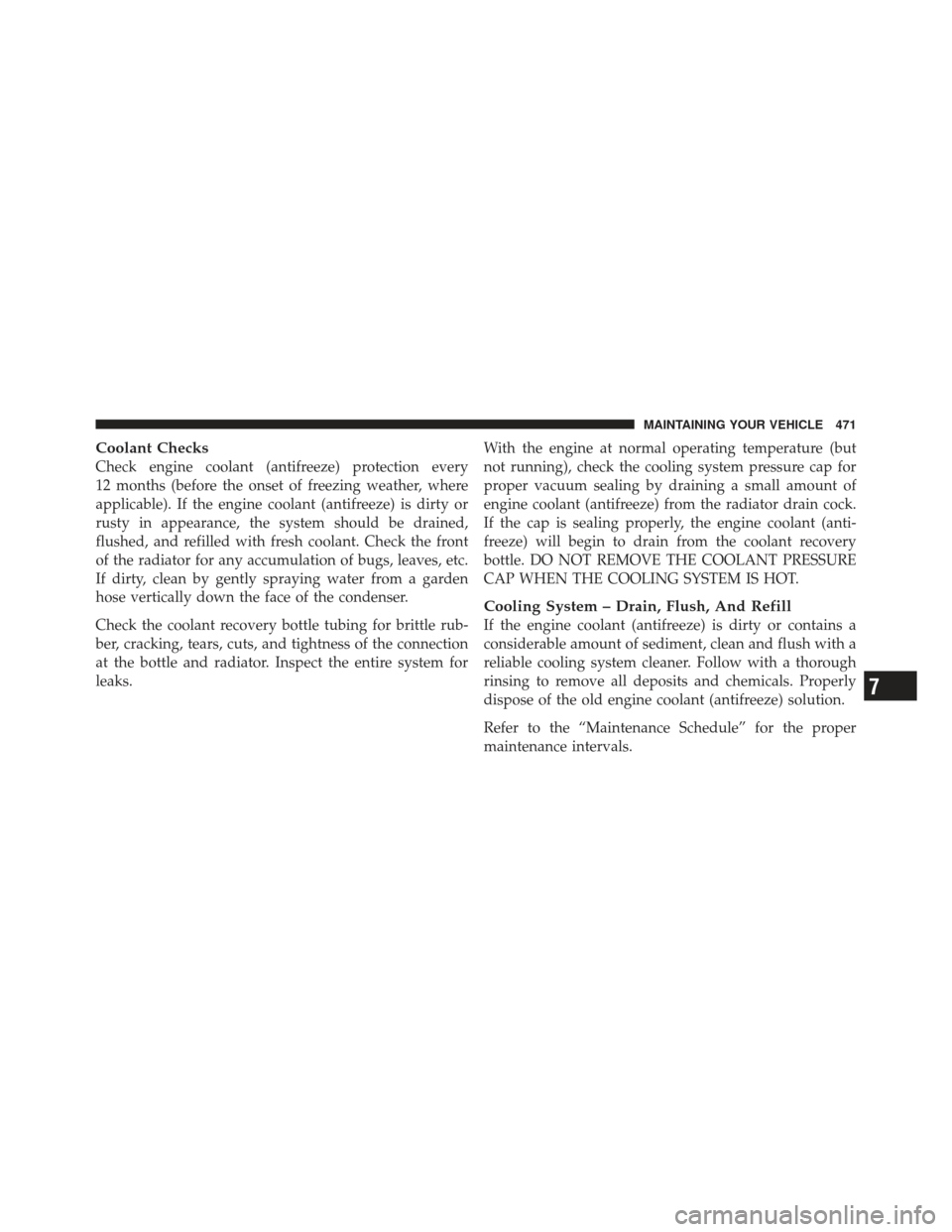
Coolant Checks
Check engine coolant (antifreeze) protection every
12 months (before the onset of freezing weather, where
applicable). If the engine coolant (antifreeze) is dirty or
rusty in appearance, the system should be drained,
flushed, and refilled with fresh coolant. Check the front
of the radiator for any accumulation of bugs, leaves, etc.
If dirty, clean by gently spraying water from a garden
hose vertically down the face of the condenser.
Check the coolant recovery bottle tubing for brittle rub-
ber, cracking, tears, cuts, and tightness of the connection
at the bottle and radiator. Inspect the entire system for
leaks.With the engine at normal operating temperature (but
not running), check the cooling system pressure cap for
proper vacuum sealing by draining a small amount of
engine coolant (antifreeze) from the radiator drain cock.
If the cap is sealing properly, the engine coolant (anti-
freeze) will begin to drain from the coolant recovery
bottle. DO NOT REMOVE THE COOLANT PRESSURE
CAP WHEN THE COOLING SYSTEM IS HOT.
Cooling System – Drain, Flush, And Refill
If the engine coolant (antifreeze) is dirty or contains a
considerable amount of sediment, clean and flush with a
reliable cooling system cleaner. Follow with a thorough
rinsing to remove all deposits and chemicals. Properly
dispose of the old engine coolant (antifreeze) solution.
Refer to the “Maintenance Schedule” for the proper
maintenance intervals.
7
MAINTAINING YOUR VEHICLE 471
Page 476 of 557
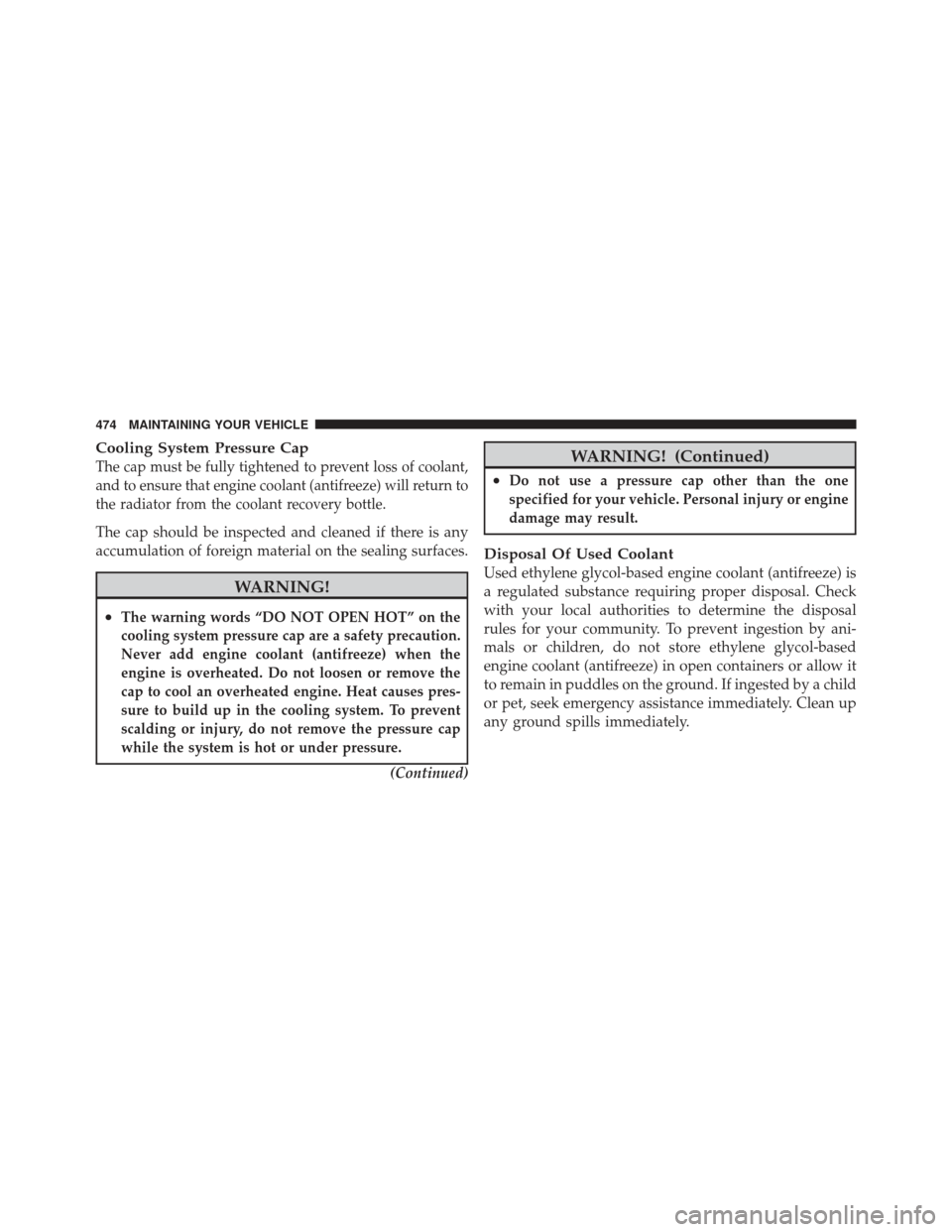
Cooling System Pressure Cap
The cap must be fully tightened to prevent loss of coolant,
and to ensure that engine coolant (antifreeze) will return to
the radiator from the coolant recovery bottle.
The cap should be inspected and cleaned if there is any
accumulation of foreign material on the sealing surfaces.
WARNING!
•The warning words “DO NOT OPEN HOT” on the
cooling system pressure cap are a safety precaution.
Never add engine coolant (antifreeze) when the
engine is overheated. Do not loosen or remove the
cap to cool an overheated engine. Heat causes pres-
sure to build up in the cooling system. To prevent
scalding or injury, do not remove the pressure cap
while the system is hot or under pressure.
(Continued)
WARNING! (Continued)
•Do not use a pressure cap other than the one
specified for your vehicle. Personal injury or engine
damage may result.
Disposal Of Used Coolant
Used ethylene glycol-based engine coolant (antifreeze) is
a regulated substance requiring proper disposal. Check
with your local authorities to determine the disposal
rules for your community. To prevent ingestion by ani-
mals or children, do not store ethylene glycol-based
engine coolant (antifreeze) in open containers or allow it
to remain in puddles on the ground. If ingested by a child
or pet, seek emergency assistance immediately. Clean up
any ground spills immediately.
474 MAINTAINING YOUR VEHICLE
Page 477 of 557
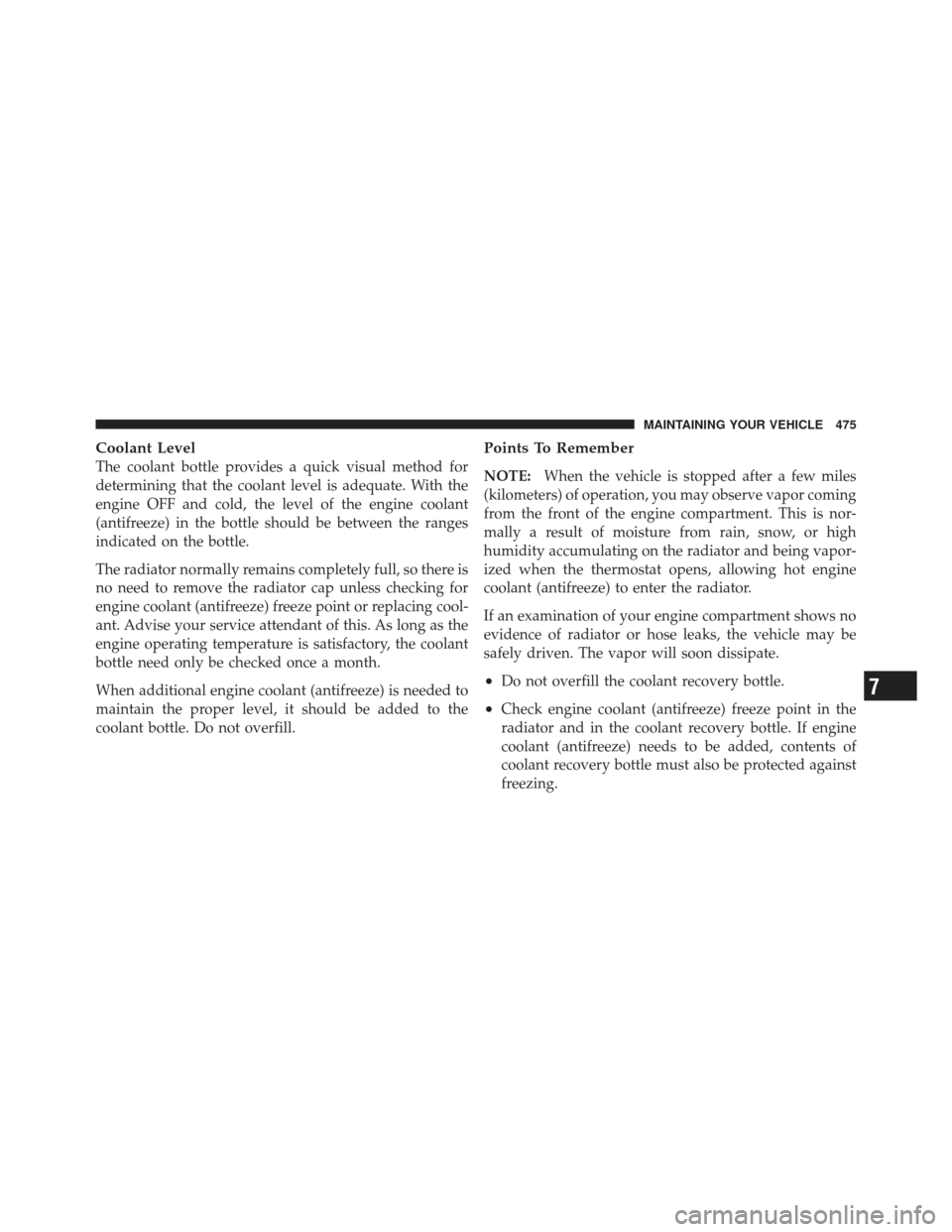
Coolant Level
The coolant bottle provides a quick visual method for
determining that the coolant level is adequate. With the
engine OFF and cold, the level of the engine coolant
(antifreeze) in the bottle should be between the ranges
indicated on the bottle.
The radiator normally remains completely full, so there is
no need to remove the radiator cap unless checking for
engine coolant (antifreeze) freeze point or replacing cool-
ant. Advise your service attendant of this. As long as the
engine operating temperature is satisfactory, the coolant
bottle need only be checked once a month.
When additional engine coolant (antifreeze) is needed to
maintain the proper level, it should be added to the
coolant bottle. Do not overfill.
Points To Remember
NOTE:When the vehicle is stopped after a few miles
(kilometers) of operation, you may observe vapor coming
from the front of the engine compartment. This is nor-
mally a result of moisture from rain, snow, or high
humidity accumulating on the radiator and being vapor-
ized when the thermostat opens, allowing hot engine
coolant (antifreeze) to enter the radiator.
If an examination of your engine compartment shows no
evidence of radiator or hose leaks, the vehicle may be
safely driven. The vapor will soon dissipate.
•Do not overfill the coolant recovery bottle.
•Check engine coolant (antifreeze) freeze point in the
radiator and in the coolant recovery bottle. If engine
coolant (antifreeze) needs to be added, contents of
coolant recovery bottle must also be protected against
freezing.
7
MAINTAINING YOUR VEHICLE 475
Page 478 of 557
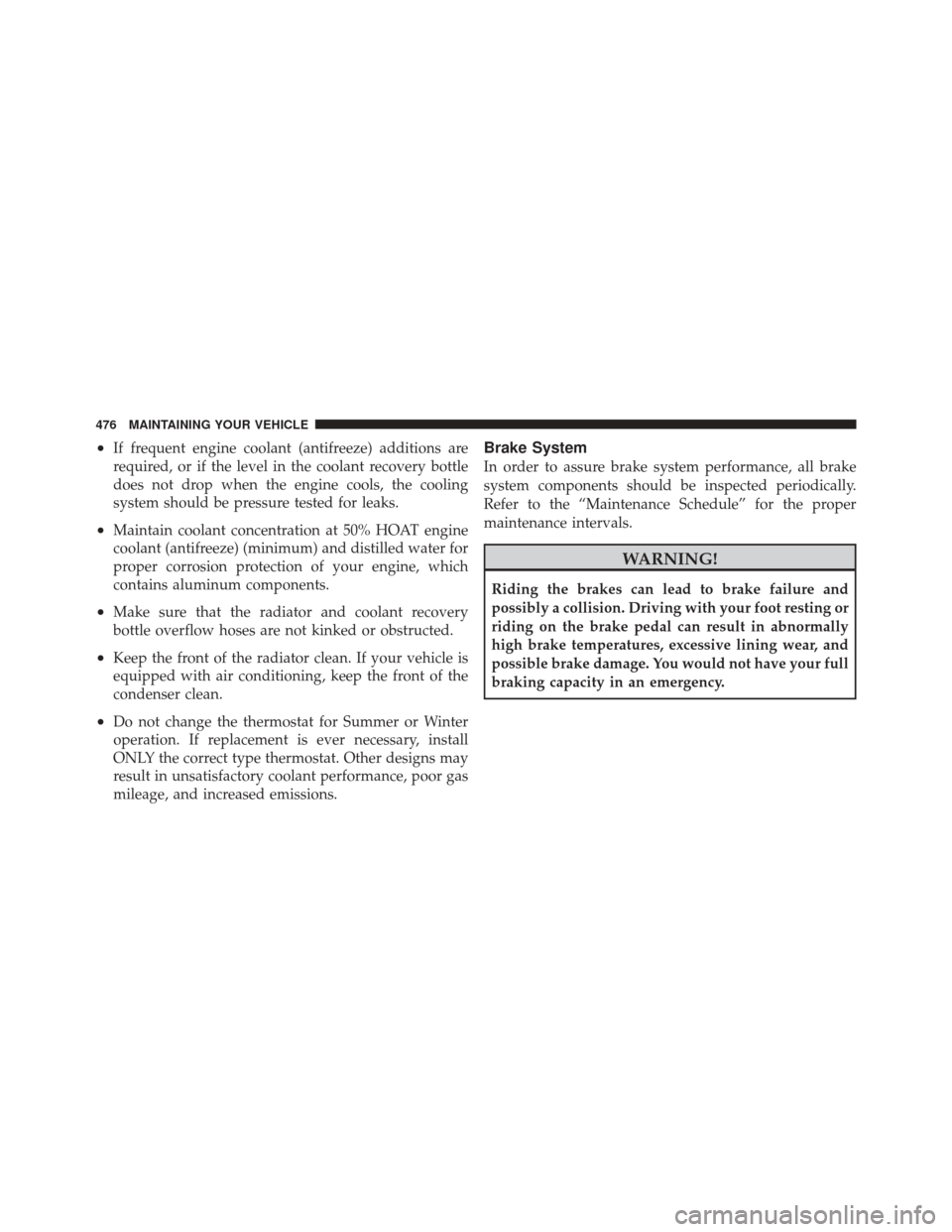
•If frequent engine coolant (antifreeze) additions are
required, or if the level in the coolant recovery bottle
does not drop when the engine cools, the cooling
system should be pressure tested for leaks.
•Maintain coolant concentration at 50% HOAT engine
coolant (antifreeze) (minimum) and distilled water for
proper corrosion protection of your engine, which
contains aluminum components.
•Make sure that the radiator and coolant recovery
bottle overflow hoses are not kinked or obstructed.
•Keep the front of the radiator clean. If your vehicle is
equipped with air conditioning, keep the front of the
condenser clean.
•Do not change the thermostat for Summer or Winter
operation. If replacement is ever necessary, install
ONLY the correct type thermostat. Other designs may
result in unsatisfactory coolant performance, poor gas
mileage, and increased emissions.
Brake System
In order to assure brake system performance, all brake
system components should be inspected periodically.
Refer to the “Maintenance Schedule” for the proper
maintenance intervals.
WARNING!
Riding the brakes can lead to brake failure and
possibly a collision. Driving with your foot resting or
riding on the brake pedal can result in abnormally
high brake temperatures, excessive lining wear, and
possible brake damage. You would not have your full
braking capacity in an emergency.
476 MAINTAINING YOUR VEHICLE
Page 538 of 557
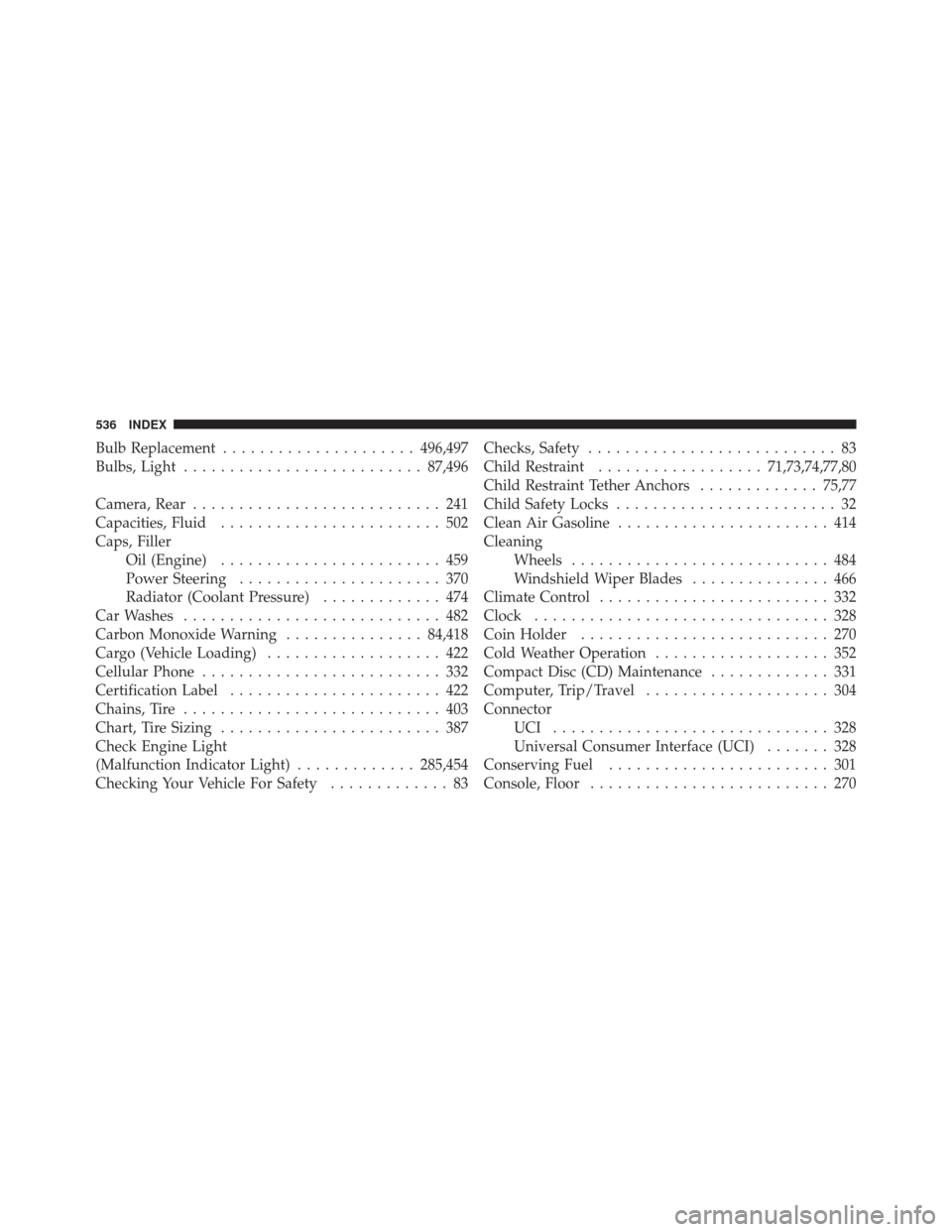
Bulb Replacement..................... 496,497
Bulbs, Light .......................... 87,496
Camera, Rear ........................... 241
Capacities, Fluid ........................ 502
Caps, Filler Oil (Engine) ........................ 459
Power Steering ...................... 370
Radiator (Coolant Pressure) ............. 474
Car Washes ............................ 482
Carbon Monoxide Warning ...............84,418
Cargo (Vehicle Loading) ................... 422
Cellular Phone .......................... 332
Certification Label ....................... 422
Chains, Tire ............................ 403
Chart, Tire Sizing ........................ 387
Check Engine Light
(Malfunction Indicator Light) .............285,454
Checking Your Vehicle For Safety ............. 83Checks, Safety
........................... 83
Child Restraint .................. 71,73,74,77,80
Child Restraint Tether Anchors .............75,77
Child Safety Locks ........................ 32
Clean Air Gasoline ....................... 414
Cleaning Wheels ............................ 484
Windshield Wiper Blades ............... 466
Climate Control ......................... 332
Clock ................................ 328
Coin Holder ........................... 270
Cold Weather Operation ................... 352
Compact Disc (CD) Maintenance ............. 331
Computer, Trip/Travel .................... 304
Connector UCI .............................. 328
Universal Consumer Interface (UCI) ....... 328
Conserving Fuel ........................ 301
Console, Floor .......................... 270
536 INDEX
Page 539 of 557
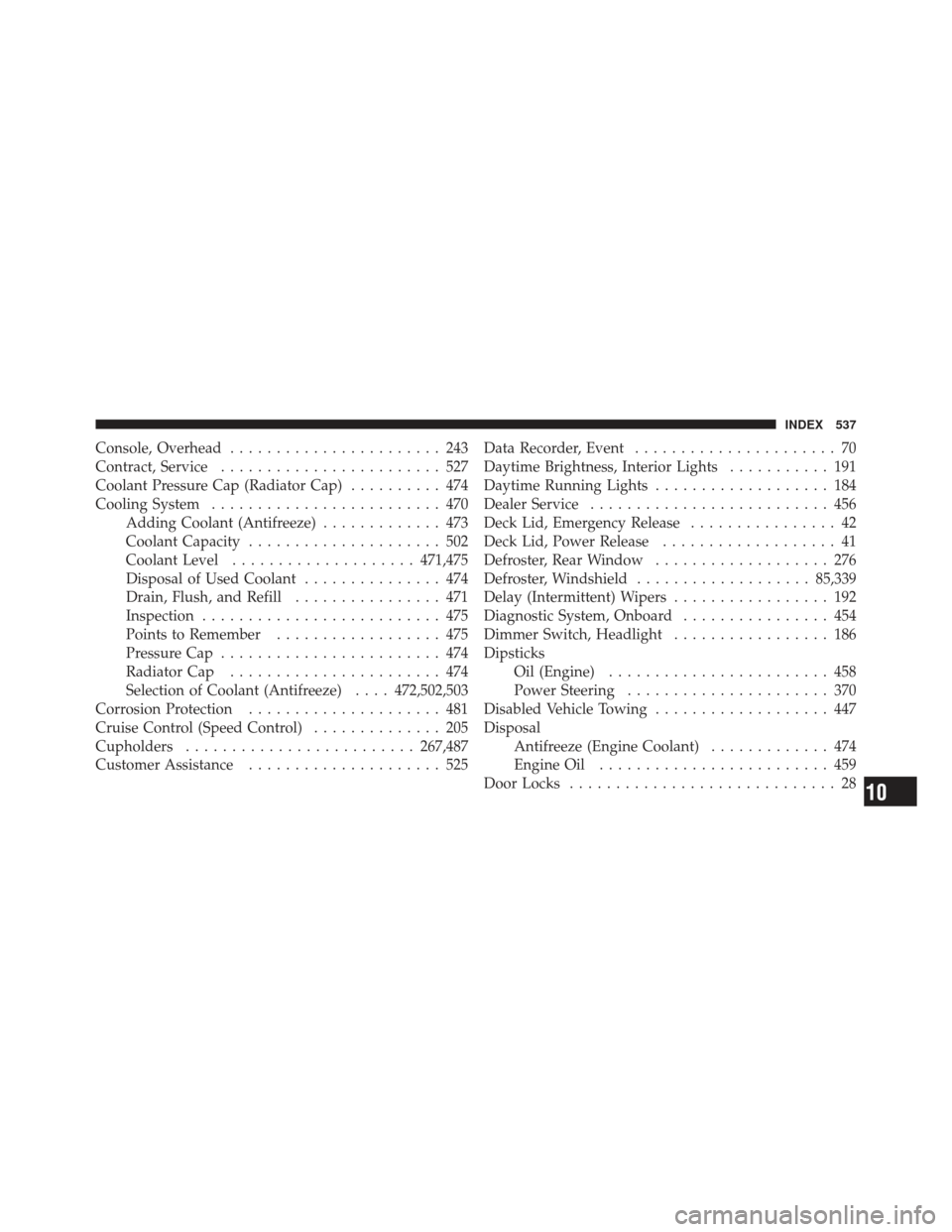
Console, Overhead....................... 243
Contract, Service ........................ 527
Coolant Pressure Cap (Radiator Cap) .......... 474
Cooling System ......................... 470
Adding Coolant (Antifreeze) ............. 473
Coolant Capacity ..................... 502
Coolant Level .................... 471,475
Disposal of Used Coolant ............... 474
Drain, Flush, and Refill ................ 471
Inspection .......................... 475
Points to Remember .................. 475
Pressure Cap ........................ 474
Radiator Cap ....................... 474
Selection of Coolant (Antifreeze) ....472,502,503
Corrosion Protection ..................... 481
Cruise Control (Speed Control) .............. 205
Cupholders ......................... 267,487
Customer Assistance ..................... 525 Data Recorder, Event
...................... 70
Daytime Brightness, Interior Lights ........... 191
Daytime Running Lights ................... 184
Dealer Service .......................... 456
Deck Lid, Emergency Release ................ 42
Deck Lid, Power Release ................... 41
Defroster, Rear Window ................... 276
Defroster, Windshield ................... 85,339
Delay (Intermittent) Wipers ................. 192
Diagnostic System, Onboard ................ 454
Dimmer Switch, Headlight ................. 186
Dipsticks Oil (Engine) ........................ 458
Power Steering ...................... 370
Disabled Vehicle Towing ................... 447
Disposal Antifreeze (Engine Coolant) ............. 474
Engine Oil ......................... 459
Door Locks ............................. 28
10
INDEX 537